Physical Address
304 North Cardinal St.
Dorchester Center, MA 02124
A 44-year-old nulliparous female presents with vaginal discharge. A vaginal tumor is biopsied, revealing invasive melanoma. On physical exam, there is a 5 cm polypoid and mostly hypopigmented lesion with a broad base arising from the right lateral vaginal wall starting at 3 cm from the vaginal introitus and extending approximately 4 cm along the lateral vaginal wall. A positron emissions tomography (PET) scan notes a F-18-fluorodeoxyglucose (FDG)-avid vaginal mass but no other evidence of metastasis. Magnetic resonance imaging (MRI) of the brain is normal. MRI of the pelvis reveals a circumscribed 3.5 cm × 3 cm × 4.7 cm intermediate T2 signal tumor in the upper to mid vagina spanning the entire thickness of vaginal wall ( Fig. 17.1 ). How do you treat this patient?
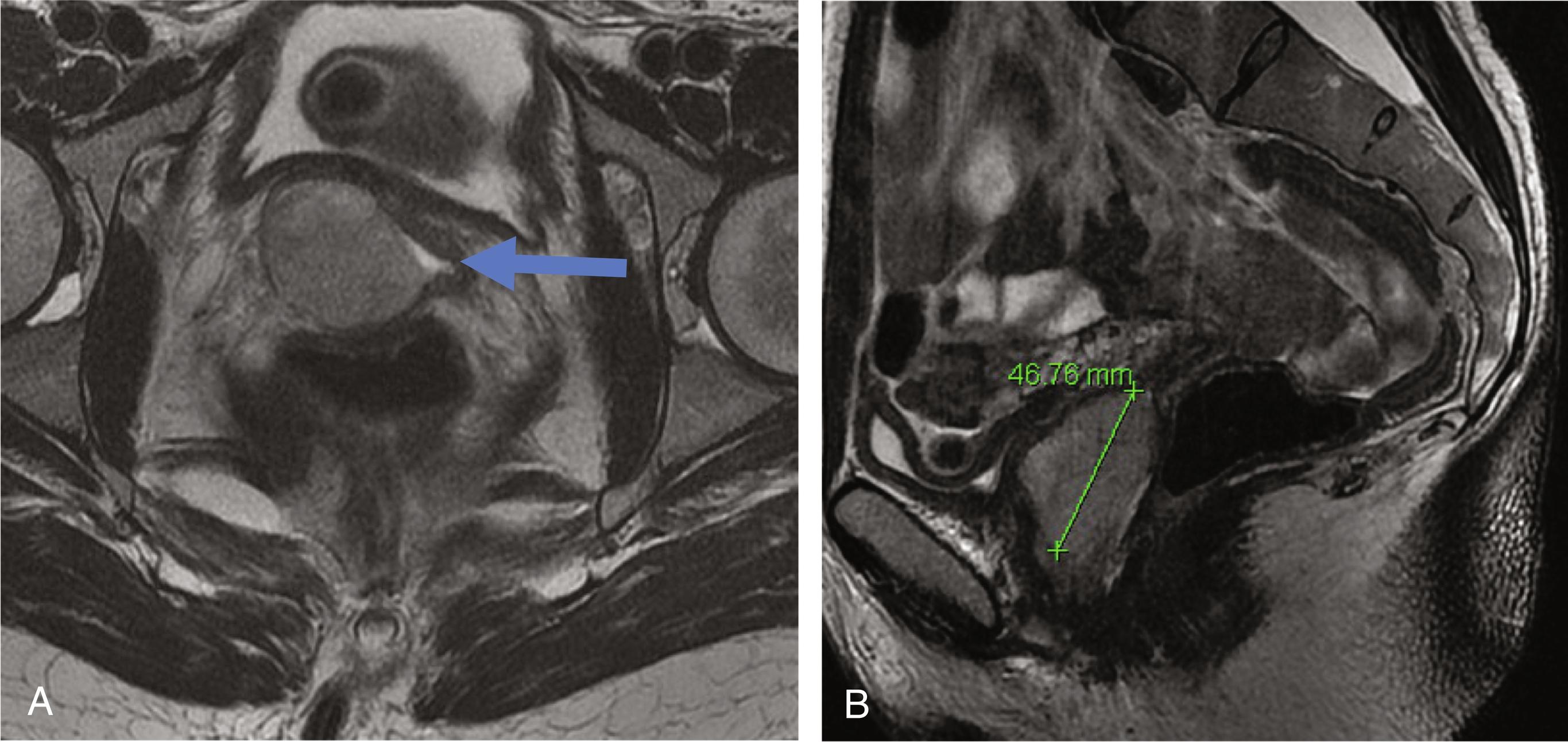
Vulvovaginal (vulvar/vaginal) melanomas are often treated as one entity, but the incidence and mortality of each differs. Although we consider them “mucosal” melanomas, it is unclear whether vulvar and vaginal melanomas are true “mucosal” melanomas. In 2020, an estimated 6120 vulvar cancers were diagnosed in the United States ; and on average, 1350 vaginal cancers are diagnosed each year. Melanoma accounts for only 6% of vulvar cancers and 9% of vaginal cancers in the Unites States, totaling approximately 500 newly diagnosed cases of vulvovaginal melanoma per year. The median age at diagnosis for vulvovaginal melanoma is 68 years. The median age at diagnosis for vulvar melanoma is slightly younger than that for vaginal melanoma. The range of ages is much wider for vulvar melanomas, with cases reported in girls as young as 10 years old and women as old as 99 years of age. At least 85% of women with vulvar melanoma are white, 4%–12% are Hispanic, and approximately 1%–4% each are African-America, Asian, or of other races. It is more difficult to precisely ascertain race distribution for vaginal melanomas ; however, a large SEER dataset analysis noted that approximately 9.5% of women with vaginal melanoma are African-American, compared to 3.5% of those with vulvar melanoma. The age-adjusted annual incidence rates for vulvovaginal melanomas are 1.9 for whites and 1.0 for non-whites per million women.
Vulvovaginal melanoma is associated with a worse overall survival (OS) compared to other vulvar cancers, as well as compared to cutaneous melanomas. The 5-year OS rate for vulvar melanoma is 59% compared to 76% for squamous cell carcinoma and 92% for adenocarcinoma. Survival appears to vary based on race, as well as whether the primary site is the vulva or vagina ( Table 17.1 ). It is unclear, however, why African-American women have worse survival. Vulvovaginal melanomas seem to be diagnosed at more advanced stages compared to other vulvar cancers, as well as cutaneous melanomas, which may explain the differences in survival as a group overall. Individually, vaginal melanomas present at more advanced stages compared to vulvar melanomas, likely due to anatomic location, leading to delayed diagnoses and worse survival. For vulvar melanomas, survival seems to be worse stage-for-stage compared to squamous cell carcinomas and adenocarcinomas. It also seems that stage-for-stage, women with vaginal melanoma have a worse survival compared to those with vulvar melanoma.
| Vulvovaginal melanoma combined | Cutaneous melanoma | P-value | |
|---|---|---|---|
| Black Non-black |
16 months 39 months |
124 months 319 months |
< 0.0001 < 0.0001 |
| Vulvar melanoma alone | Cutaneous melanoma | ||
| Black Non-black |
33 months 58 months |
124 months 319 months |
0.0057 < 0.0001 |
| Vaginal melanoma alone | Cutaneous melanoma | ||
| Black Non-black |
8.5 months 19 months |
124 months 319 months |
< 0.0001 < 0.0001 |
| Vulvar melanoma | Vaginal melanoma | ||
| Black Non-black |
33 months 58 months |
8.5 months 19 months |
0.0135 < 0.0001 |
Vulvovaginal melanomas are not associated with chronic sun damage (CSD) as are acral and other non-CSD skin melanomas and are generally categorized as mucosal melanomas. There are no known etiologic or well-established risk factors for vulvovaginal melanomas. There are a few reported inherited genetic mutations that increase the lifetime risk of cutaneous and uveal melanomas. These include CDKN2A, CDK4, POT1, TERT, BRCA1&2, BAP1, MITF, XPC, XPD, XPA, PTEN, and TP53. There are no reports, however, on the association of risk of vulvovaginal, or mucosal melanomas in general with these specific hereditary syndromes. A maxillary mucosal melanoma in a 21-year-old with Li–Fraumeni syndrome has been reported.
A retrospective analysis of 81 genital or anorectal mucosal melanomas (GAMMs) over a 33-year period compared to 293 cutaneous melanomas attempted to address the familial/hereditary risk of these mucosal melanomas. The majority of the GAMM cases were women (88%) and were vulvar/vaginal melanomas (68%). Other cases included anorectal, penile, and cervical melanomas. The rate of cases with multiple other primary melanomas was similar (6% for GAMM and 5.3% for cutaneous melanoma). A family history of any-type melanoma was noted in 18% of the GAMM cases compared to 7.5% of the cutaneous cases. Germline testing for CDKN2A was performed in 17 of the GAMM cases, and none of these patients had a germline mutation. Although a germline mutation was not identified, the authors suggested that GAMMs are part of familial/hereditary syndromes based on the increased family history of melanoma in GAMM patients. This very small retrospective series is far from conclusive or definitive. However, careful vulvovaginal examination along with the recommended whole-body skin examinations is prudent in patients with known germline mutations and strong familial history of any type of melanoma. Biopsy of any new or concerning (or even if not too concerning) vulvovaginal lesions should be performed in patients with these hereditary syndromes.
Primary melanomas of the vulva are characterized by conspicuous histopathologic overlap with primary cutaneous melanomas. However, the exact nature, i.e., whether a vulvar melanoma is mucosal or cutaneous remains one of the most challenging questions for the following reasons: (i) although some may be confined to the cutaneous or mucosal epithelia of the various parts of vulva, the mucocutaneous junction may also be the site of origin for vulvar melanomas; (ii) many of the vulvar melanomas are large with broad lentiginous or nodular patterns of growth at the time of presentation and therefore, may extend across the mucocutaneous junction, irrespective of initial cutaneous or mucosal origin; (iii) mucosal melanomas are frequently multifocal and thus, may involve various parts of the vulva; for instance, both the ipsilateral labium majus and labium minus, or across the midline; (iv) although most are pigmented, approximately 25% of vulvar melanomas may be amelanotic, thus, precluding determination of gross extent of tumor; (v) since pruritus is one of the most common presenting symptoms, chronic scratching-related low-grade trauma can lead to prominent lichenification of squamous mucosa with acquisition of granular and thick cornified layers; therefore, the histologic distinction of mucosa from skin is further muddled. Therefore, collaborative efforts of gynecologists and oncologists documenting the precise anatomic location(s) of grossly visible lesion and histopathologic evaluation detailing the extent of melanoma along cutaneous and mucosal epithelia by pathologists is essential to determine whether a given vulvar melanoma is principally mucosal or cutaneous in nature.
In majority of the cases, primary vulvar melanomas are characterized by a lesion, which is frequently ulcerated. At least focal pigmentation is noted in majority of the cases. However, some cases may lack pigmentation. In those arising from preexisting melanosis or melanocytic lesion, a recent change in color, size, and shape is a clue to malignant transformation.
Primary melanomas of the vulva display histopathologic features akin to their cutaneous counterparts, and the American Joint Committee on Cancer (AJCC) recommends vulvar melanomas to be analyzed and staged according to the criteria established for primary cutaneous melanomas. The histopathologic features to be assessed and reported in vulvar melanomas are summarized in Table 17.2 . Majority of the primary vulvar melanomas are invasive. However, in rare instances, the patient may have long-standing melanoma in-situ before developing invasive disease. Multifocal disease and skip lesions are common in vulvar melanomas.
| Histopathologic feature | AJCC recommended | CAP recommended |
|---|---|---|
| Histologic type | Yes | |
| Clark a /anatomic b level | ||
| Breslow a /tumor b thickness | Yes | Yes |
| Radial (non-tumorigenic) growth phase | ||
| Vertical (tumorigenic) growth phase | ||
| Mitotic rate (number/mm 2 ) | Yes | Yes |
| Ulceration | Yes | Yes |
| Regression | ||
| Lymphovascular invasion | Yes | |
| Perineural invasion | ||
| Microscopic satellitosis | Yes | Yes |
| Tumor-infiltrating lymphocytes | ||
| Associated precursor melanocytic nevus | ||
| Predominant cytology | ||
| Margins | Yes |
a Used in evaluation of primary melanomas of cutaneous origin.
b Used in evaluation of primary melanomas of mucosal origin.
Primary vulvar melanomas are characterized by architectural and cytopathologic abnormalities. The growth pattern of primary vulvar melanomas is most commonly lentiginous: contiguous proliferation of atypical single melanocytes along the basal layer of stratified squamous epithelium interspersed by a few nests ( Fig. 17.2 ), or nodular: absence of a radial growth phase, in which the intraepithelial component is either absent or does not extend beyond the invasive component ( Fig. 17.3 ). Rare cases of superficial spreading type, characterized by proliferation of predominantly nests of varying sizes and shapes with pagetoid scatter of atypical melanocytes within the suprabasal layers of stratified squamous epithelium ( Fig. 17.4 ) may also be seen, particularly among those that arise from cutaneous surfaces. The in-situ/ intraepithelial component is typically characterized by poor circumscription as well as asymmetry ( Fig. 17.5 ) and often involves the adnexal structures such as vaginal glands and folliculo-sebaceous units extensively.
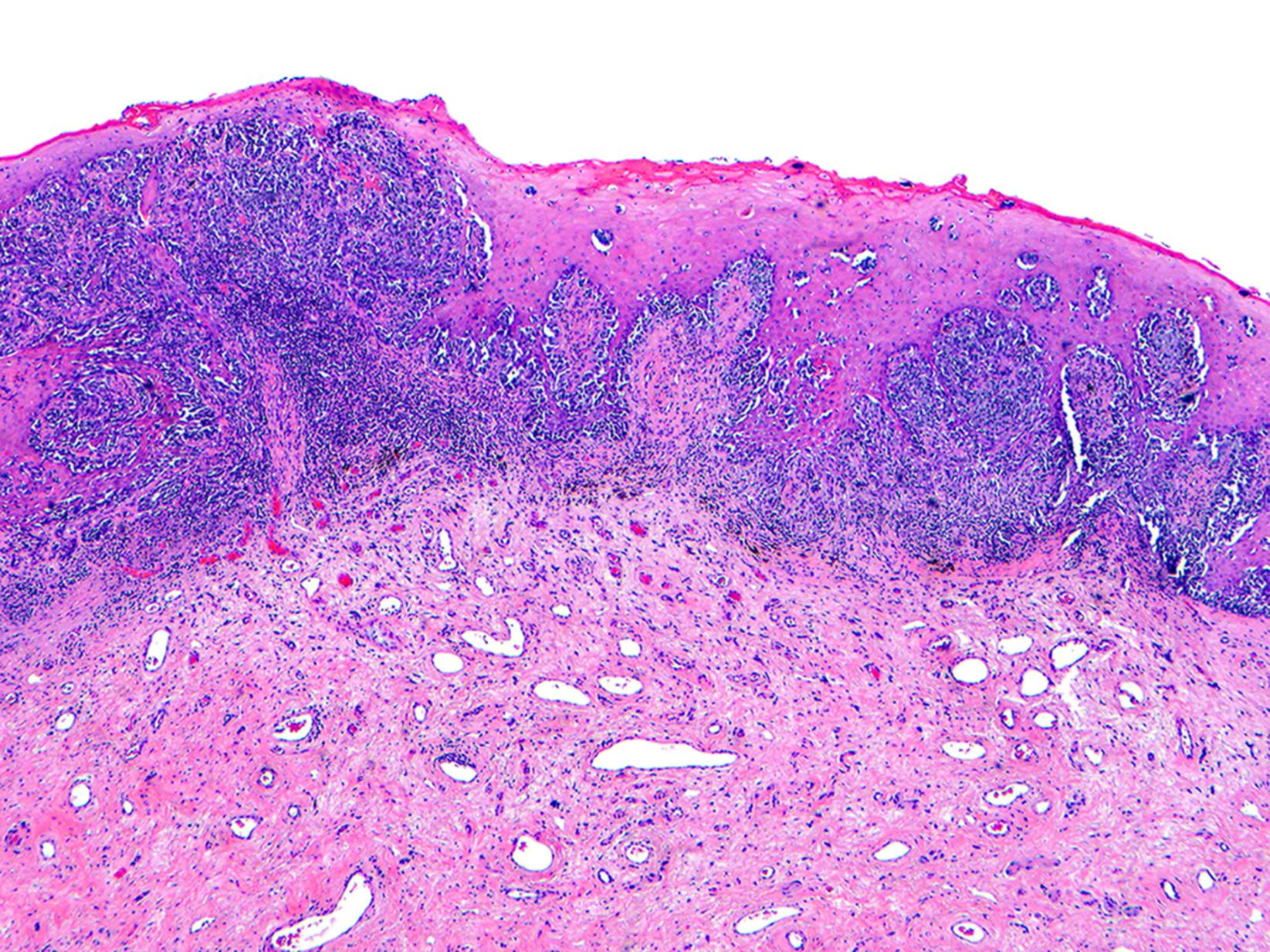
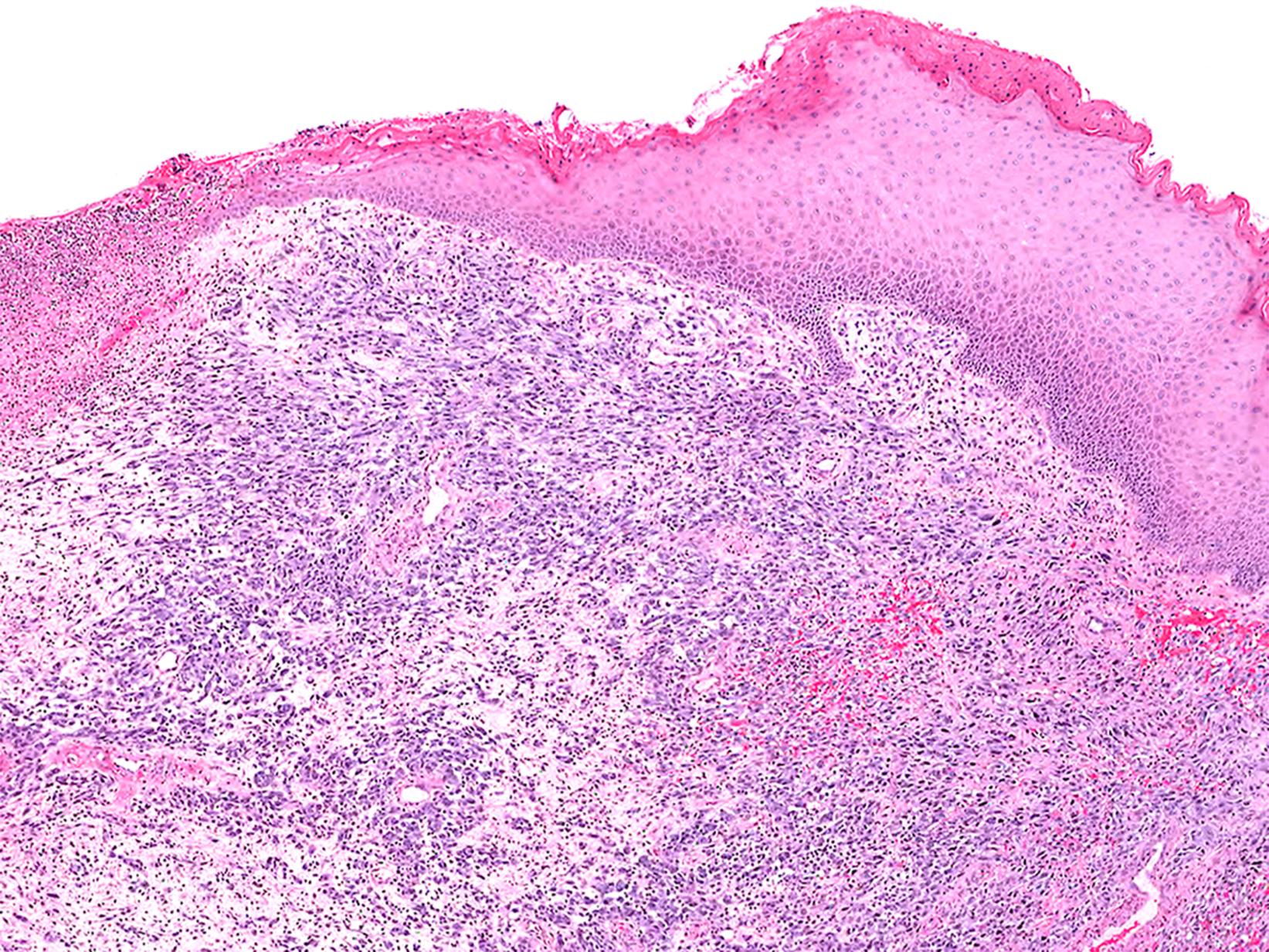
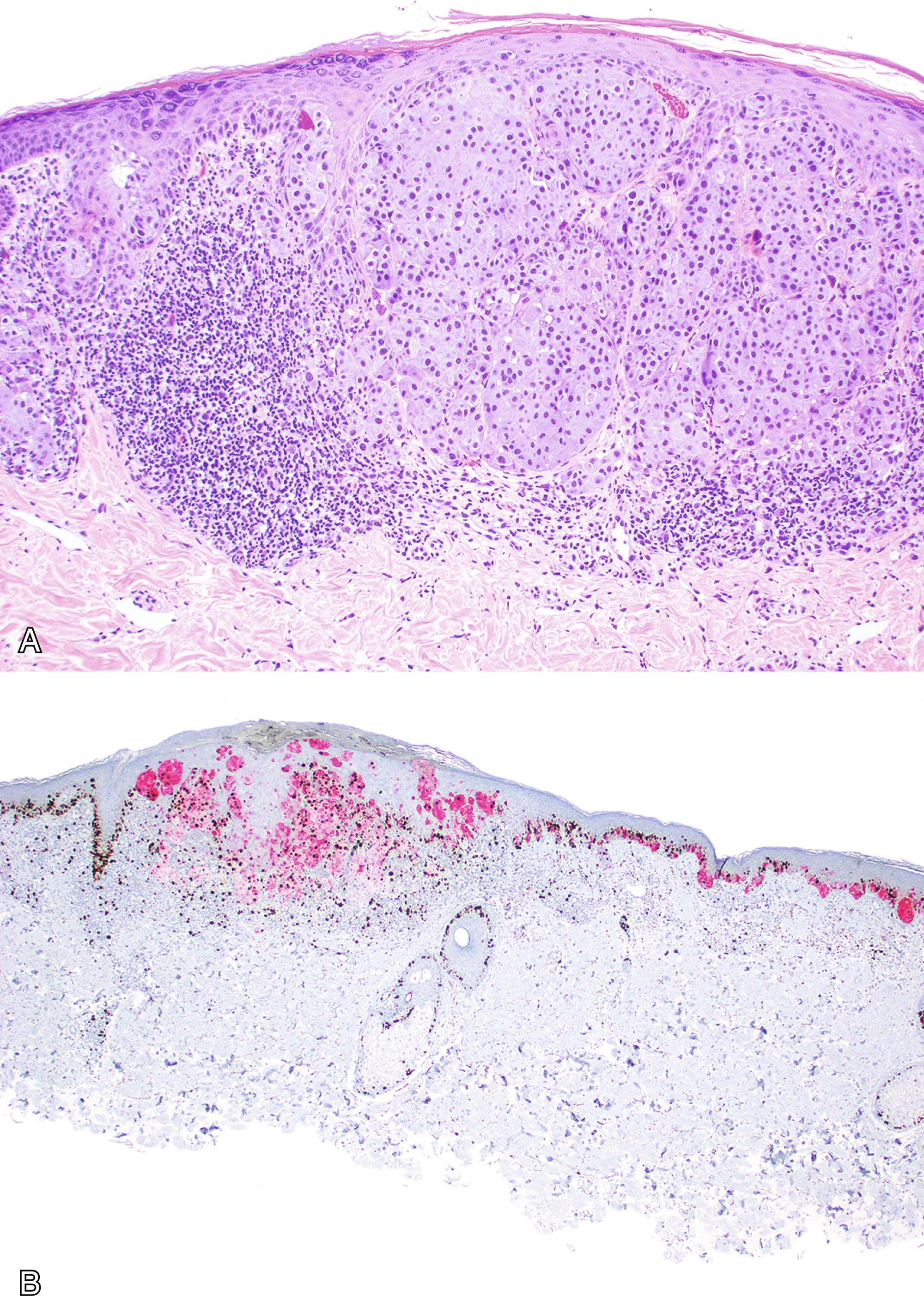
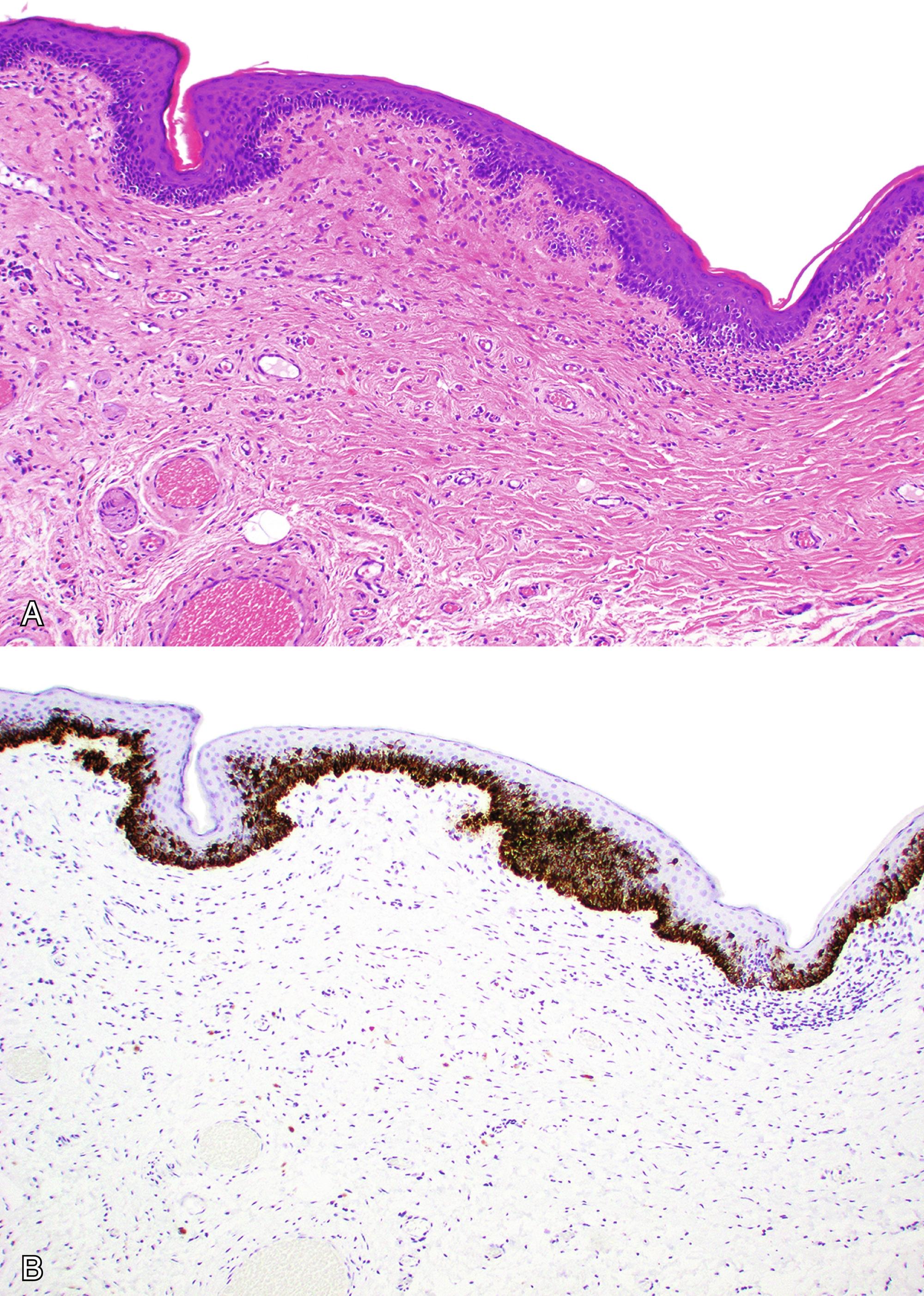
The extent of dermal/submucosal involvement by melanoma may be evaluated using various methods including (i) Breslow/tumor thickness, (ii) Clark/anatomic level and (iii) Chung level ( Fig. 17.6 , Table 17.3 ). Of these, the AJCC has incorporated the Breslow/ tumor thickness in staging of primary melanomas. In view of the lack of well-defined papillary dermis in mucosae, Clark level is not applicable to primary vulvar melanomas; the term “anatomic” level is recommended instead ( Table 17.2 ). The invasive component is characterized by irregular proliferation of melanocytes within the dermis and/or submucosa with varying degrees of cytologic atypia, absence of maturation of melanocytes with deeper descent and mitotic activity, including atypical forms ( Fig. 17.7 ).
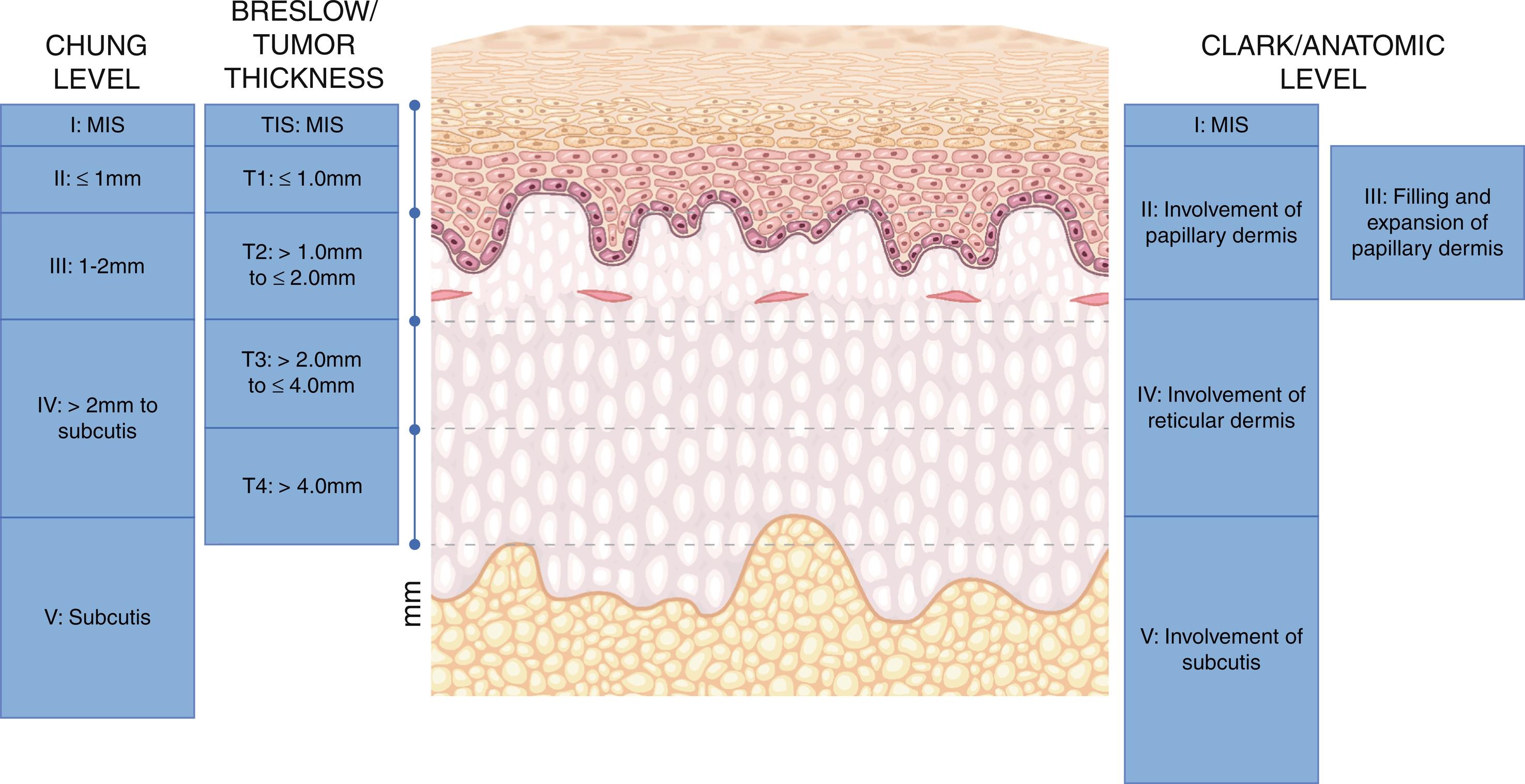
| Breslow/ tumor thickness | Clark/ anatomic level | Chung level |
|---|---|---|
| T0: Melanoma in situ | I: Melanoma in situ | I: Melanoma in situ |
| T1: Tumor thickness ≤ 1.0 mm | II: Invasive melanoma involves the papillary dermis | II: Invasion ≤ 1 mm |
| T2: Tumor thickness > 1.0 mm to ≤ 2.0 mm | III: Invasive melanoma fills and expands the papillary dermis | III: Invasion 1–2 mm |
| T3: Tumor thickness > 2.0 mm to ≤ 4.0 mm | IV: Invasive melanoma involves the reticular dermis | IV: Invasion > 2 mm |
| T4: Tumor thickness > 4.0 mm | V: Invasive melanoma involves the subcutis | V: Invasion into subcutis |
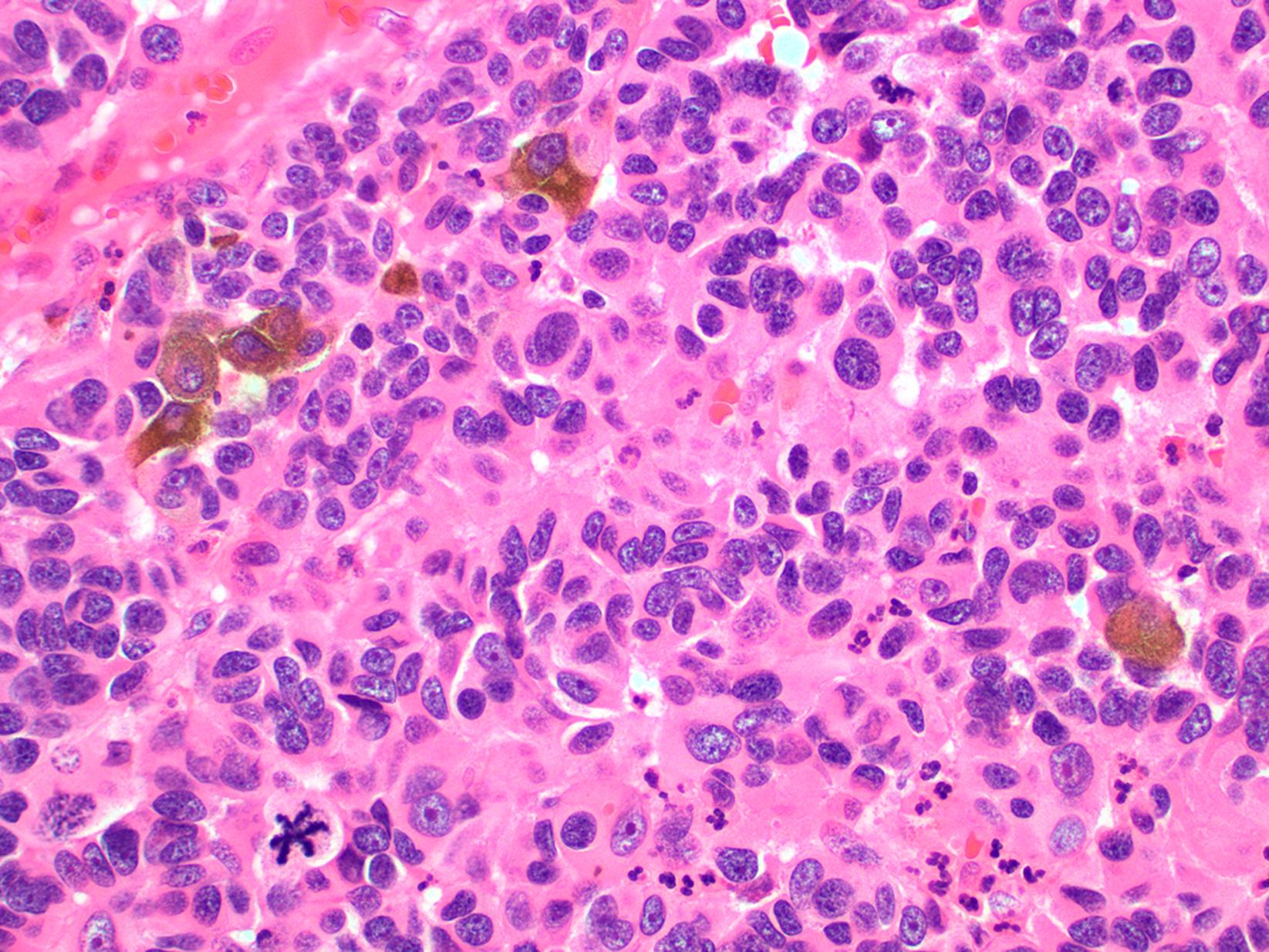
The maximum depth of invasive tumor, referred to as Breslow thickness in primary melanomas of cutaneous origin and tumor thickness in melanomas of mucosal origin is the parameter of most prognostic importance. It is typically measured from the (i) top of granular layer in keratinized stratified squamous epithelium, (ii) top of nucleated layer in nonkeratinized stratified squamous epithelium or (iii) base of ulcer to the deepest extent of tumor. In particular, tumor thickness > 2 mm and mitotic rate of ≥ 2/mm 2 of the invasive component correlated with poor disease-specific survival (DSS) in a retrospective analysis of 100 cases of primary vulvar melanomas.
Melanoma-associated ulceration ( Fig. 17.8 ) is more frequent in primary vulvar melanomas (in up to 50%) compared to primary cutaneous melanomas. Even though ulceration correlated with overall and DSS by univariate analysis, it did not emerge as an independent prognostic parameter of overall and disease-specific survival after multivariable analysis. Lymphovascular invasion (LVI) ( Fig. 17.9 ), neurotropism or perineural invasion (PNI) ( Fig. 17.10 ) and microscopic satellitosis may also be present.
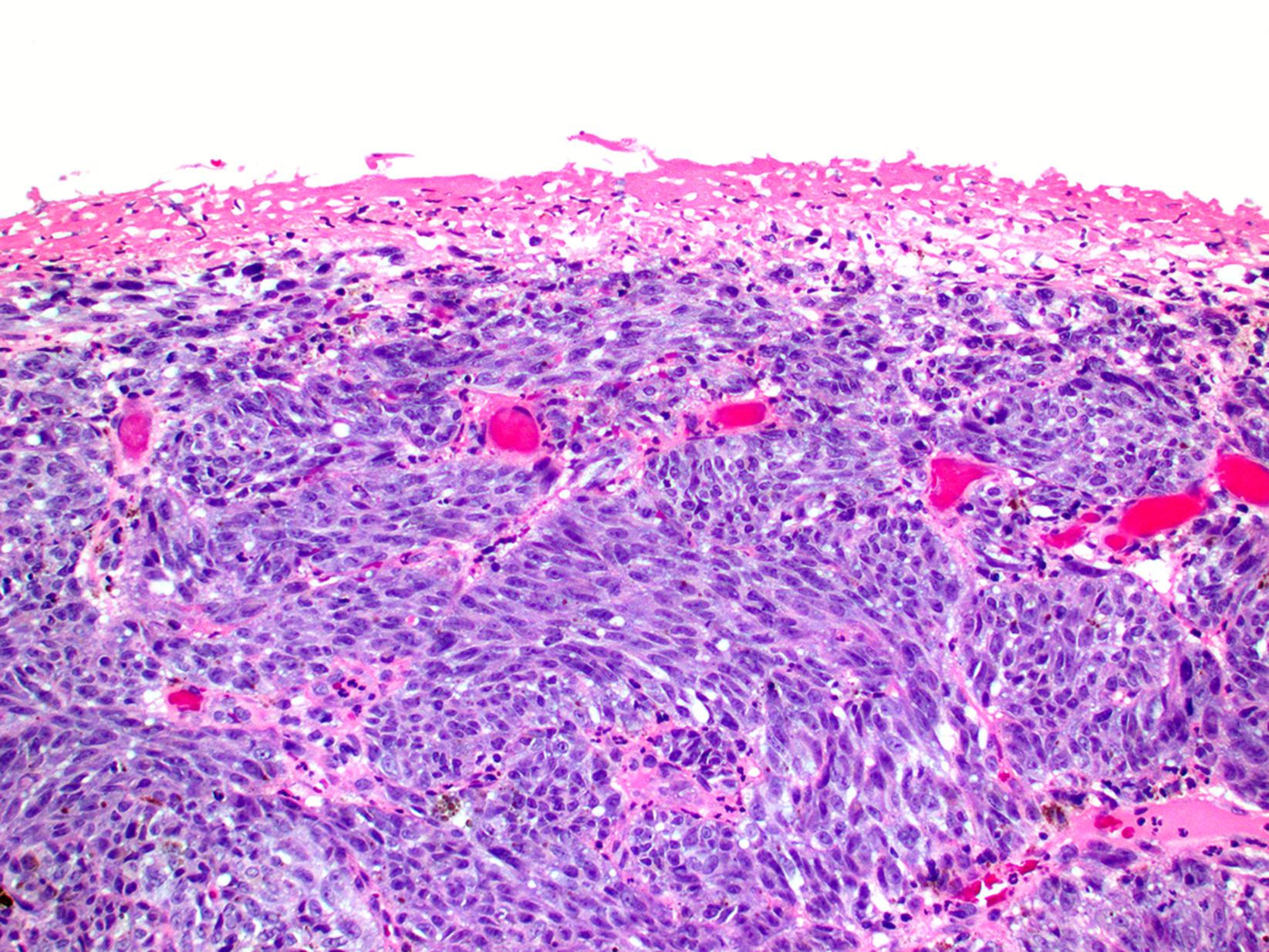
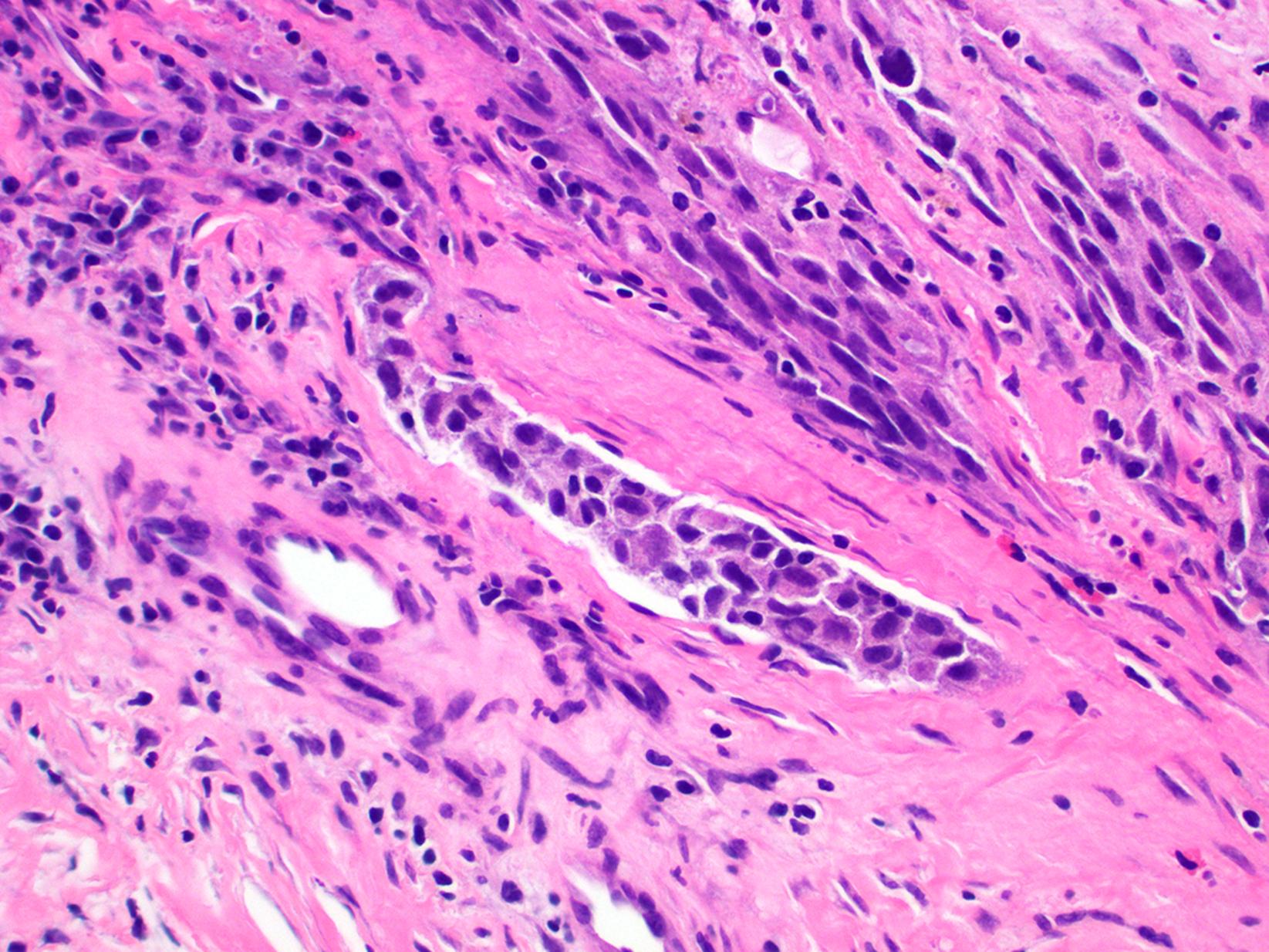
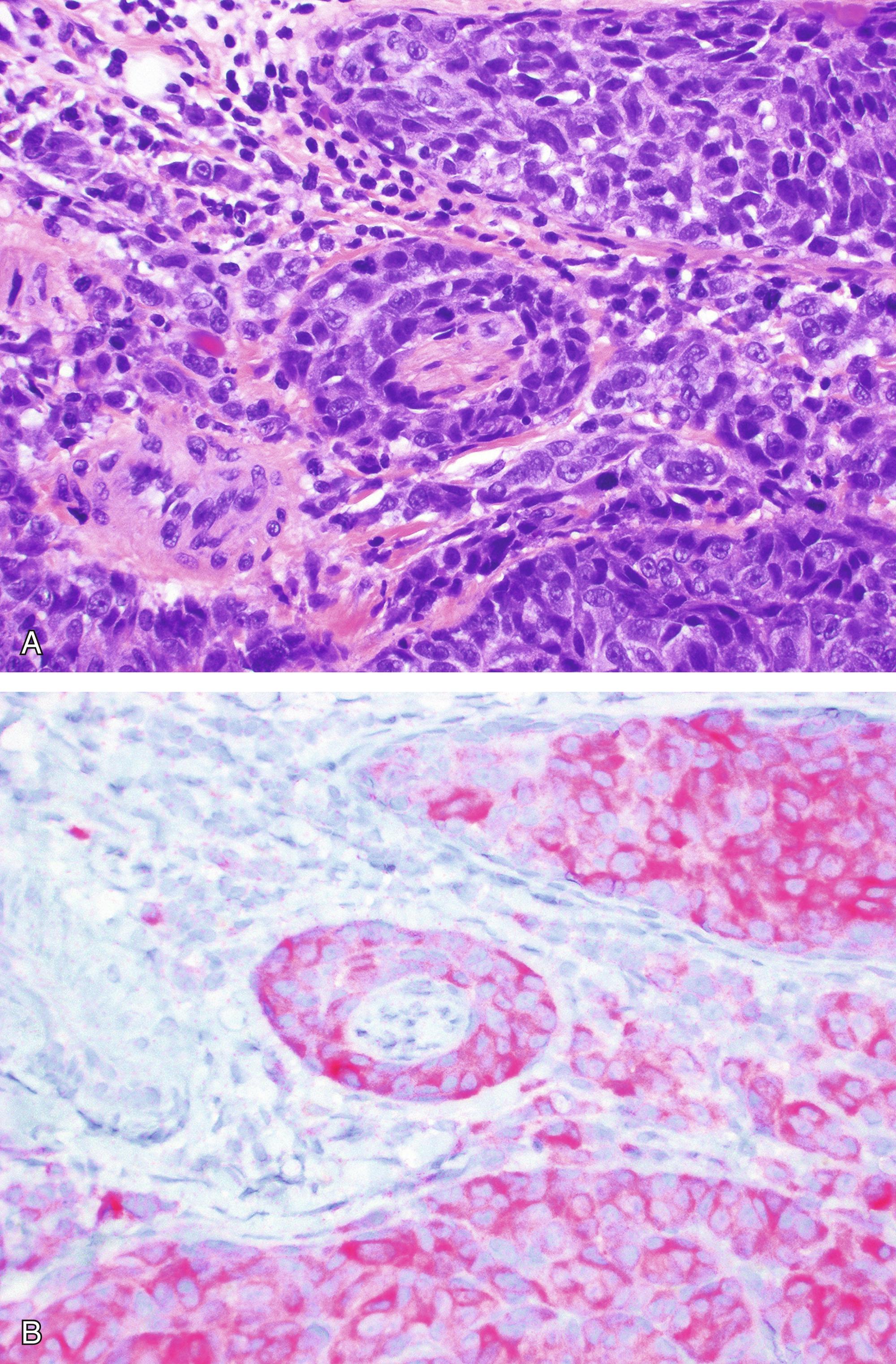
The melanoma cells may be of epithelioid or spindled cytology and are typically characterized by varying amounts of pale amphophilic or eosinophilic cytoplasm, fine-dusty pigmentation, ovoid nuclei, vesicular chromatin and prominent nucleoli. In some cases, cytoplasmic pigmentation may be completely absent. Infrequently, the melanoma cells may be of nevoid cytology in which the cytologic atypia is subtle with small ovoid hyperchromatic nuclei, condensed chromatin and inconspicuous nucleoli.
In limited biopsies or when the cytoplasmic pigmentation is minimal, melanocytic origin may be difficult to appreciate; thus, requiring use of immunohistochemical studies. Employing a panel of immunohistochemical markers, including melanocytic markers such as MelanA, HMB45, tyrosinase, MITF, S100 and SOX10; keratinocytic markers including cytokeratin cocktail(s), p63 and p40; as well as vascular markers including CD34, CD31, and ERG. Typically, primary melanomas of the vulva tend to be MelanA + HMB45-patchy + tyrosinase + MITF + S100 + SOX10 + cytokeratin cocktail(s)- p63- p40- CD34- CD31- ERG-. In some advanced cases, the tumors may have undergone de-differentiation resulting in loss of expression of melanocytic markers with acquisition of keratinocytic markers such as cytokeratin and less likely, p63. In such scenarios, SOX10 remains the most sensitive marker to demonstrate melanocytic differentiation. SOX10 may also be used as an ancillary test to determine margin status. Presence of LVI may be highlighted using endothelial markers such as D2-40 or CD31 as well as cocktails such as SOX10/CD31 and MITF/D2-40.
Majority of vulvar melanomas are pigmented; therefore, the clinical differential diagnoses include all pigmented or dark lesions of the vulva of reactive and neoplastic origin ( Fig. 17.11 ). Pigmented vulvar lesions may be present in up to 12% of white women, of which 10%–19% may be melanocytic in origin. Documentation of the following features is important for optimal diagnosis, management and follow-up: type: rash vs. lesion and palpability; relationship with surrounding skin: well-defined vs. merging; the precise anatomic location(s); color: dark, reddish/ violaceous, brown-black and intralesional variability; multiplicity; size; shape; evidence of associated disease such as lichen sclerosus; nature of specimen submitted: excisional biopsy (recommended for small lesions to include a rim of normal skin) vs. partial biopsy and location of biopsy site (in large lesions). It is also imperative to document any underlying diseases such as lichen sclerosus, diabetes, systemic lupus erythematosus, lichen planus, etc.
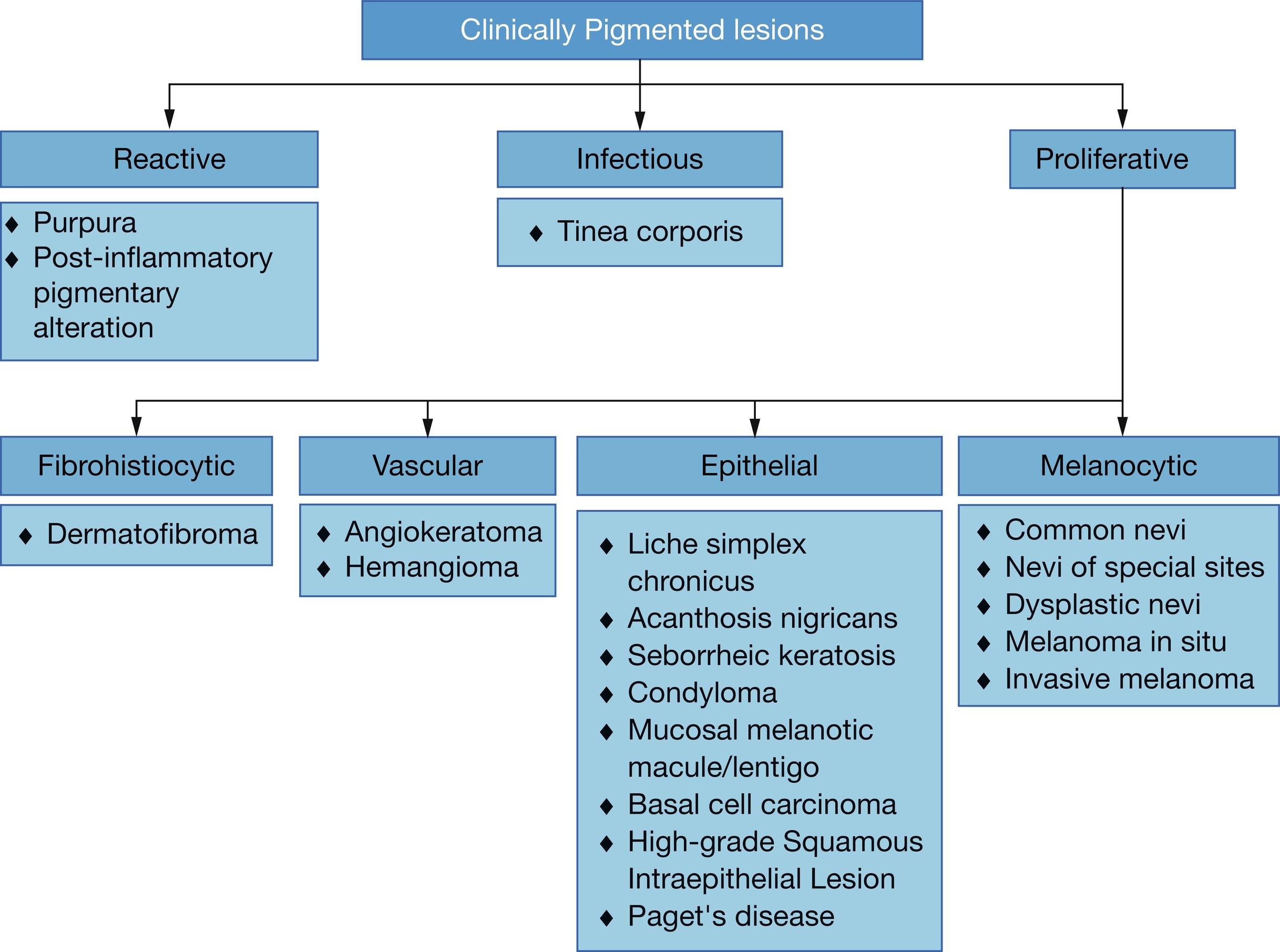
When compared to primary cutaneous melanomas, genomic instability is more frequent in mucosal melanomas, manifesting in the form of copy number changes and structural variations, whereas point mutation burden is overall lower. Structural variations targeting TERT , CDK4 , and MDM2 genes are common. Whole-genome sequencing of mucosal melanomas has revealed almost 10-fold increased frequency of single nucleotide variants when compared to primary cutaneous melanomas. Commonly mutated genes include SF3B1 , NRAS , NF1 , KIT , TP53 , SPRED1 , BRAF , ATRX , HLA-A, and CHD8 of which NF1 and KIT co-mutations can also occur. Preferential mutations of TERT and ATRX correlated with shorter telomere lengths. BRAF mutations are more frequent in primary vulvar melanomas compared to other types of anogenital melanomas, likely due to cutaneous origin.
Become a Clinical Tree membership for Full access and enjoy Unlimited articles
If you are a member. Log in here